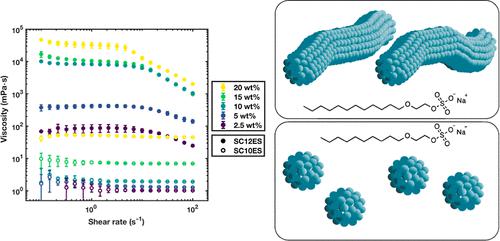Our official English website, www.x-mol.net, welcomes your
feedback! (Note: you will need to create a separate account there.)
Influence of Surfactant Structure on Polydisperse Formulations of Alkyl Ether Sulfates and Alkyl Amidopropyl Betaines
Langmuir ( IF 3.7 ) Pub Date : 2023-12-28 , DOI: 10.1021/acs.langmuir.3c02380 Ashley P Williams 1 , Anna V Sokolova 2 , Jonathan M Faber 1 , Calum S G Butler 1 , Pierre Starck 3 , Nick J Ainger 3 , Kellie L Tuck 1 , Raymond R Dagastine 4 , Rico F Tabor 1
Langmuir ( IF 3.7 ) Pub Date : 2023-12-28 , DOI: 10.1021/acs.langmuir.3c02380 Ashley P Williams 1 , Anna V Sokolova 2 , Jonathan M Faber 1 , Calum S G Butler 1 , Pierre Starck 3 , Nick J Ainger 3 , Kellie L Tuck 1 , Raymond R Dagastine 4 , Rico F Tabor 1
Affiliation

|
Surfactants provide detergency, foaming, and texture in personal care formulations, yet the micellization of typical industrial primary and cosurfactants is not well understood, particularly in light of the polydisperse nature of commercial surfactants. Synergistic interactions are hypothesized to drive the formation of elongated wormlike self-assemblies in these mixed surfactant systems. Small-angle neutron scattering, rheology, and pendant drop tensiometry are used to examine surface adsorption, viscoelasticity, and self-assembly structure for wormlike micellar formulations comprising cocoamidopropyl betaine, and its two major components laurylamidopropyl betaine and oleylamidopropyl betaine, with sodium alkyl ethoxy sulfates. The tail length of sodium alkyl ethoxy sulfates was related to their ability to form wormlike micelles in electrolyte solutions, indicating that a tail length greater than 10 carbons is required to form wormlike micelles in NaCl solutions, with the decyl homologue unable to form elongated micelles and maintaining a low viscosity even at 20 wt % surfactant loading with 4 wt % NaCl present. For these systems, the incorporation of a disperse ethoxylate linker does not enable shorter chain surfactants to elongate into wormlike micelles for single-component systems; however, it could increase the interactions between surfactants in mixed surfactant systems. For synergy in surfactant mixing, the nonideal regular solution theory is used to study the sulfate/betaine mixtures. Tail mismatch appears to drive lower critical micelle concentrations, although tail matching improves synergy with larger relative reductions in critical micelle concentrations and greater micelle elongation, as seen by both tensiometric and scattering measurements.
中文翻译:

表面活性剂结构对烷基醚硫酸盐和烷基酰胺丙基甜菜碱多分散配方的影响
表面活性剂在个人护理配方中提供去污力、起泡性和质感,但典型工业主表面活性剂和助表面活性剂的胶束化尚不清楚,特别是考虑到商业表面活性剂的多分散性质。假设协同相互作用可驱动这些混合表面活性剂体系中细长蠕虫状自组装体的形成。使用小角中子散射、流变学和悬滴张力测定法来检查包含椰油酰氨基丙基甜菜碱及其两种主要成分月桂酰氨基丙基甜菜碱和油酰氨基丙基甜菜碱以及烷基乙氧基硫酸钠的蠕虫状胶束制剂的表面吸附、粘弹性和自组装结构。烷基乙氧基硫酸钠的尾长与其在电解质溶液中形成蠕虫状胶束的能力有关,表明尾部长度大于10个碳才能在氯化钠溶液中形成蠕虫状胶束,而癸基同系物无法形成拉长的胶束,即使在 20 wt% 表面活性剂负载和 4 wt% NaCl 存在下也能保持低粘度。对于这些系统,分散乙氧基化物连接体的掺入不能使短链表面活性剂伸长成单组分系统的蠕虫状胶束;然而,它可以增加混合表面活性剂体系中表面活性剂之间的相互作用。为了表面活性剂混合中的协同作用,使用非理想正则溶液理论来研究硫酸盐/甜菜碱混合物。尾部不匹配似乎会导致较低的临界胶束浓度,尽管尾部匹配通过临界胶束浓度的相对较大降低和较大的胶束伸长提高了协同作用,如张力测量和散射测量所示。
更新日期:2023-12-28
中文翻译:

表面活性剂结构对烷基醚硫酸盐和烷基酰胺丙基甜菜碱多分散配方的影响
表面活性剂在个人护理配方中提供去污力、起泡性和质感,但典型工业主表面活性剂和助表面活性剂的胶束化尚不清楚,特别是考虑到商业表面活性剂的多分散性质。假设协同相互作用可驱动这些混合表面活性剂体系中细长蠕虫状自组装体的形成。使用小角中子散射、流变学和悬滴张力测定法来检查包含椰油酰氨基丙基甜菜碱及其两种主要成分月桂酰氨基丙基甜菜碱和油酰氨基丙基甜菜碱以及烷基乙氧基硫酸钠的蠕虫状胶束制剂的表面吸附、粘弹性和自组装结构。烷基乙氧基硫酸钠的尾长与其在电解质溶液中形成蠕虫状胶束的能力有关,表明尾部长度大于10个碳才能在氯化钠溶液中形成蠕虫状胶束,而癸基同系物无法形成拉长的胶束,即使在 20 wt% 表面活性剂负载和 4 wt% NaCl 存在下也能保持低粘度。对于这些系统,分散乙氧基化物连接体的掺入不能使短链表面活性剂伸长成单组分系统的蠕虫状胶束;然而,它可以增加混合表面活性剂体系中表面活性剂之间的相互作用。为了表面活性剂混合中的协同作用,使用非理想正则溶液理论来研究硫酸盐/甜菜碱混合物。尾部不匹配似乎会导致较低的临界胶束浓度,尽管尾部匹配通过临界胶束浓度的相对较大降低和较大的胶束伸长提高了协同作用,如张力测量和散射测量所示。





















































 京公网安备 11010802027423号
京公网安备 11010802027423号